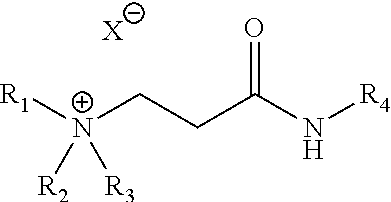Composition and method for reducing hydrate agglomeration
a technology of hydrate agglomeration and composition, which is applied in the direction of gaseous fuels, transportation and packaging, other chemical processes, etc., can solve the problems of hydrate plugs, pipeline damage, safety hazards for field workers, and extended length, so as to prevent hydrate plugs and not negatively affect the overboard water quality
- Summary
- Abstract
- Description
- Claims
- Application Information
AI Technical Summary
Benefits of technology
Problems solved by technology
Method used
Image
Examples
example 1
[0064]A representative synthetic scheme is given below for the synthesis of N-butyl-N-(3-(cocoamino)-3-oxopropyl)butan-1-aminium acetate.
[0065]
[0066]To a 250-mL, 3-neck round bottom flask was added 40.00 g (0.31 mol) dibutylamine and a magnetic stirbar. The flask was fitted with a thermocouple, reflux condenser, and addition funnel containing 22.30 g (0.31 mol) acrylic acid. The acrylate was added to the stirring amine slowly. Once the addition was complete, the addition funnel was replaced with a glass stopper and the reaction mixture was heated at 120° C. for 2 hours. Upon cooling to ambient temperature, an orange solid was formed. Complete conversion was confirmed by the disappearance of the dibutylamine starting material by TLC (1 / 5 CHCl3 / MeOH with 0.5% v / v NH4OH). To the orange solid was added 60.58 g (0.31 mol) cocoamine. An insulated Dean-Stark trap was attached to the apparatus between the flask and reflux condenser for water removal. The reaction mixture was heated at 165° ...
example 2
[0067]A representative synthetic scheme is given below for the synthesis of N,N-dibutyl-N-(3-(cocoamino)-3-oxopropyl)hexan-1-aminium bromide.
[0068]
[0069]To a 250-mL, 3-neck round bottom flask was added 40.00 g (0.31 mol) dibutylamine and a magnetic stirbar. The flask was fitted with a thermocouple, reflux condenser, and addition funnel containing 22.30 g (0.31 mol) acrylic acid. The acrylate was added to the stirring amine slowly. Once the addition was complete, the addition funnel was replaced with a glass stopper and the reaction mixture was heated at 120° C. for 2 hours. Upon cooling to ambient temperature, an orange solid was formed. Complete conversion was confirmed by the disappearance of the dibutylamine starting material by TLC (1 / 5 CHCl3 / MeOH with 0.5% v / v NH4OH). To the orange solid was added 60.58 g (0.31 mol) cocoamine. An insulated Dean-Stark trap was attached to the apparatus between the flask and reflux condenser for water removal. The reaction mixture was heated at 1...
example 3
[0070]Samples 1 to 4 of Table 1 are the cationic ammonium products of the reaction of acrylic or acetic acid with the adduct formed from the addition of commercially available acrylic acid to dibutylamine followed by amidation with cocoamine. Samples 5 to 10 are the quaternization products of the reaction of 1-chlorobutane, 1-bromobutane, or 1-bromohexane with the adduct formed from the addition of commercially available acrylic acid to dibutylamine followed by amidation with cocoamine. All of the ammonium species are soluble in 2-propanol (IPA), methanol, ethylene glycol (MEG), ethylene glycol monobutyl ether (EGMBE), glycerol, heavy aromatic naphtha (HAN) and combinations thereof. Samples 1 to 10 were dissolved to 40% w / w for the anti-agglomeration test.
[0071]
TABLE 1New anti-agglomerant chemistriesSampleR1R2R3R4XSolvent1C4H9C4H9HcocoacrylateMeOH2C4H9C4H9HcocoacetateMeOH3C4H9C4H9HcocoacrylateIPA4C4H9C4H9HcocoacetateIPA5C4H9C4H9C4H9cocoClIPA / MeOH6C4H9C4H9C4H9cocoBrIPA / MeOH7C4H9C4H9C...
PUM
| Property | Measurement | Unit |
|---|---|---|
| thickness | aaaaa | aaaaa |
| inner diameter | aaaaa | aaaaa |
| inner diameter | aaaaa | aaaaa |
Abstract
Description
Claims
Application Information
 Login to View More
Login to View More - R&D
- Intellectual Property
- Life Sciences
- Materials
- Tech Scout
- Unparalleled Data Quality
- Higher Quality Content
- 60% Fewer Hallucinations
Browse by: Latest US Patents, China's latest patents, Technical Efficacy Thesaurus, Application Domain, Technology Topic, Popular Technical Reports.
© 2025 PatSnap. All rights reserved.Legal|Privacy policy|Modern Slavery Act Transparency Statement|Sitemap|About US| Contact US: help@patsnap.com



